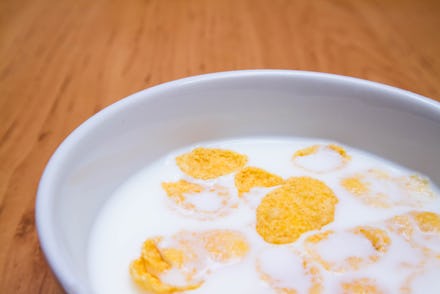This is why eating cereal makes you so sleepy

When you think breakfast, you might think cereal. It's easy to prepare, it's just as easy to eat in a rush and it comes in enough varieties to keep you intrigued — with sweetened flakes and clusters for a lifetime. But is cereal really the best breakfast option?
"It definitely depends on the type of cereal [you] eat," nutritionist Jennifer Gibson, head of health coaching at Vida, said in an interview. "If you go for a good, healthy cereal, something that has a lot of whole grains and is low in sugar, as it goes through the body it definitely takes a little bit longer to digest because of all the extra fiber in the system. If it has a little bit of protein, those carbohydrates are released a little more slowly into the blood, so it gives you a more steady stream of energy."
For healthier options, Gibson recommended a bowl of Kellogg's Mini-Wheats (unfrosted) or Kashi Go Lean, as well as hot cereals like steel-cut oats, millet, amaranth and buckwheat groats. Bonus: You get to say "groats" when someone asks you what you ate for breakfast. (Push the limit even further and go for zoats.)
So what about when you can't resist the colorful, sugary stuff?
"If it's a cereal that is more full of refined carbohydrates and has a big sugar punch, then you'll see that energy spike right away," Gibson said. "You'll get a surge of energy [about 20 minutes after eating your cereal], but then you'll have a really pretty severe crash in your blood sugar a couple hours after you eat that cereal."
Think of it this way: If you're scarfing down a sugary bowl of cereal at 7 a.m. before your commute, and you spend an hour commuting, by the time you've arrived at work or school, your blood sugar is about to crash. This will cause you to feel not only hungry but sluggish, unfocused and perhaps even craving more sugar.
Beware of low-calorie processed cereals, which are certainly not as nutritious as their small calorie-count implies. "Some of those more processed cereals, they don't have a ton of calories. The only calories that they do have are really from those refined carbohydrates and sugar," Gibson said. "Most people are, you know, say they eat a bowl of Froot Loops in the morning — they're starving within two hours."
While the process of digesting cereal is similar for kids and adults, Gibson noted it's even more challenging for kids, who have faster metabolisms and can get hungry after eating processed cereals even faster than their parents.
To resist the crash just two hours after breakfast, choose a cereal with about 6 grams of fiber per serving, and less than 5 or 6 grams of sugar, preferably with whole grains or protein, according to Gibson. "A super-simple ingredient list is always a bonus," she said.
If you're tempted to buy a quick breakfast off the shelf, you might try something like Kix, which contain less than 2 grams of sugar per every 3/4 cup. Cheerios are another good option, as well as hot cereals like oatmeal (the unsweetened kind!), which can be topped with fruits and nuts.
When you're eating cereal, even in a hurry, Gibson recommended pairing it with some protein on the side, like a hard-boiled egg or a handful of nuts.